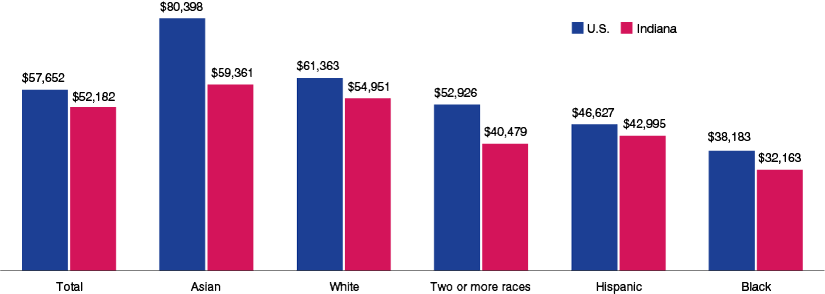Median household income by race: Why margins of error matter

At the state level, median household income ranges from about $59,000 for Asian households to about $32,000 for black households.
Indiana’s annual median household income is $52,182 (+/- $200), according to the 2017 five-year American Community Survey (ACS) estimates published by the U.S. Census Bureau. Both Asian and white households surpassed this statewide median. Meanwhile, Hispanic households and black households earned less than the statewide median (see Table 1).
For households that contain people of different races, it is the race of the householder that is used to categorize households by race. All data in this article (except for the “two or more races” category) refer to data for those who identify as a single race (i.e., “white alone” or “black alone” in Census Bureau terminology). Also, keep in mind that the bureau classifies “Hispanic” as an ethnicity, which is tabulated separately from race. In other words, Hispanic individuals can be of any race.
Table 1: Indiana’s median household income by race, 2017
| Selected categories | Median household income | Margin of error |
|---|---|---|
| Total | $52,182 | $200 |
| Asian | $59,361 | $2,836 |
| White | $54,951 | $256 |
| Hispanic | $42,995 | $1,092 |
| Two or more races | $40,479 | $1,698 |
| Black | $32,163 | $516 |
Source: American Community Survey five-year estimates
Even though Asian households are at the top of the income spectrum in Indiana, Asian households fare significantly better nationwide, with a median exceeding $80,000 (see Figure 1).
Figure 1: Comparing Indiana and U.S. median household incomes by race, 2017

Source: American Community Survey five-year estimates
State and national comparisons are all well and good, but what if you wanted to explore these data at a more local level? Unfortunately, the county-level income by race data set leaves much to be desired.
Why county-level race data from the ACS are problematic
The ACS reports margins of error at the 90 percent confidence level. In other words, if the estimate is 100 with a margin of error equal to 20, one can be 90 percent confident that the true value is between 80 and 120. When survey-based data drill in to focus on a smaller subset of the population, margins of error generally become larger. We saw this earlier in Table 1: At the statewide level, the margin of error for white households (which accounts for about 86 percent of all households) was only $256, but it was $2,836 for Asian households (2 percent of all households).
Thus, when we try to segment the population by both race and a smaller geography, some of the margins of error go sky high. Want an example? Median household income for a black household in Ripley County is $35,735 with a margin of error of $25,864. In other words, we are 90 percent sure that the true median is between $9,871 and $61,599. Here’s another estimate that’s even less useful: Median household income for Hispanics in Putnam County is $52,778 (+/- $50,948). Needless to say that when the true value of an estimate could range anywhere between $1,830 and $103,726, some red flags should go up.
So where do we go from here? We can calculate reliability thresholds based on an estimate's coefficient of variation (CV). “High reliability” is based on a CV of 12 percent or less, while “low reliability” indicates a CV exceeding 40 percent.1 Estimates with CVs between 12 and 40 are grouped into the “medium reliability” category and should be used with caution.
Table 2 shows the reliability results for median household income in Indiana counties.2 First of all, in many cases, a county-level estimate isn’t even published. All of the estimates for white households are highly reliable, but only 26 percent of counties have highly reliable Hispanic income estimates—and just 12 percent have highly reliable estimates for Asian households.
Table 2: Number of Indiana counties in each reliability category
| Reliability of median household income | Total | White | Black | Asian | Two or more races | Hispanic |
|---|---|---|---|---|---|---|
| Low reliability | 0 | 0 | 11 | 8 | 19 | 11 |
| Medium reliability | 0 | 0 | 19 | 21 | 39 | 32 |
| High reliability | 92 | 92 | 19 | 11 | 13 | 24 |
| Data not available | 0 | 0 | 43 | 52 | 21 | 25 |
| Percent of counties that are highly reliable | 100% | 100% | 21% | 12% | 14% | 26% |
Source: Author’s calculations, using American Community Survey 2017 five-year estimates
Figure 2 is an interactive graphic to allow exploration of these data by race, county and reliability. Counties shown in blue have estimates exceeding the statewide median of $52,182, while orange counties fall below that value.
Figure 2: County-level median household income by race, 2017
Source: Author’s calculations, using American Community Survey five-year estimates
For white households, Hamilton County in the Indianapolis metro topped the list with a median of $91,020 (+/- $2,071). Among the 19 counties with highly reliable data for black households, Johnson, Hendricks, Benton and Bartholomew are near the top. Ripley, Hamilton, Jasper and Porter counties have some of the highest median incomes for Hispanic households (out of the 24 counties falling in the highly reliable category). And for Asian households, Hamilton, Bartholomew and Floyd counties have the highest median incomes among the 11 counties with highly reliable data.
For those interested in income data for an area with missing or less reliable data, an alternative data source that has potential to help is the QWI Explorer—also from the Census Bureau. This tool is part of the Longitudinal Employer-Household Dynamics (LEHD) program and it leverages administrative data (such as state unemployment insurance program records). While one cannot get median household income statistics from this data set, average monthly earnings are available by race and ethnicity. There are still some data distortions, but not as many as with the ACS median household income data.
View Indiana’s 2017 Q4 data by race here: https://qwiexplorer.ces.census.gov/static/explore.html?s=f7b56&v=map&t=ac0&fc=true&st=IN#x=0&g=0
Summary
Indiana’s median household income trails the U.S. across all major race categories, with Asian households experiencing the largest gap (even though they are at the top of the Indiana income spectrum). Our knowledge of income by race at the county level is somewhat hindered by the high margins of error.
What started out as an exploration of income by race ends with advice for any and all data users: Please don’t just grab an ACS estimate (or any survey-based estimate for that matter) without looking at its margin of error. Just because a number is published doesn’t always mean it is useful.
Notes
- For more detail on these reliability thresholds and how they are calculated, please see “The American Community Survey,” Esri White Paper, July 2018, http://downloads.esri.com/Support/downloads/other_/J10020_American_Community_Survey_2018.pdf.
- Reliability thresholds were also calculated for per capita income by race at the Indiana county level. While there were fewer missing values, the number of counties falling in the high reliability category was essentially the same.
